
The purpose of this lesson is to help you, as an eCommerce professional (to-be), understand that there are different types of eCommerce business models you must be aware of if you want to be an eCommerce online worker.
You will get to learn what the most common business model types are and how we can classify them based on who’s selling to whom, how the inventory is acquired, through which channels are the goods sold.
These business types overlap and there are always new ones invented, but consider this lesson your foundation of the business model knowledge that you will build upon as you go through your career.
Developing a profitable eCommerce business is not easy. It takes time, sufficient funds, a good understanding of market demand, creativity and persistence.
You will hardly be able to do your work for an eCommerce employer properly, if you don’t understand the business model that your employer utilises.
A major factor in developing a business is matching a suitable business model with your market.
Therefore, let’s start with what the term really means. A ‘business model’ generally refers to:
‘the methods a company uses to generate revenue to sustain itself’
In simple words – ‘what a business does to make money’.
Almost every online business may have its own business model depending on its mission. Usually what works well for one company may not work at all for another.
Therefore, it’s very difficult to easily, neatly and strictly categorise eCommerce business models, but that’s exactly what we’ve tried to do here for you.
In your day-to-day life you are most likely familiar with a B2C (business to customer) business model. That’s what most people first think of when talking about eCommerce. This means that you are the end-consumer and you purchase e.g. a pair of shoes from an online store.
Have you purchased online? Perhaps you’ve bought a T-shirt, shoes or jewellery. You have been a customer for a store using the B2C business model then. But that’s the end of the business model chain.
Another aim for this lesson is to introduce you to the big world of eCommerce and show you that there is so much more behind it than ordering and receiving a T-shirt.
So, let’s take a closer look at various ways an eCommerce store can make money online. Ready to travel through the maze of the major types of eCommerce business models?
Business Models Based on Who’s Selling to Whom
Basically depending on who’s selling to whom, some most common and popular business models in eCommerce are defined as follows.
1: Business-to-Business (B2B)
Stores that follow this model sell their products to another business. Typically the buyer then resells those products to the final customer, often called the end-consumer.
How does it work in practice? Well, let’s say that e.g. Aramark sells food to a university, which further sells, that is to say, resells the food to its students on campus as end-consumers.
Other similar trading B2B platforms are Alibaba, Amazon Business, Grainger, Sprint, Bouncepad, IndiaMart, etc.
This model usually offers more frequent repeat orders and larger order sizes but sales cycles are typically longer since there are fewer businesses than consumers.
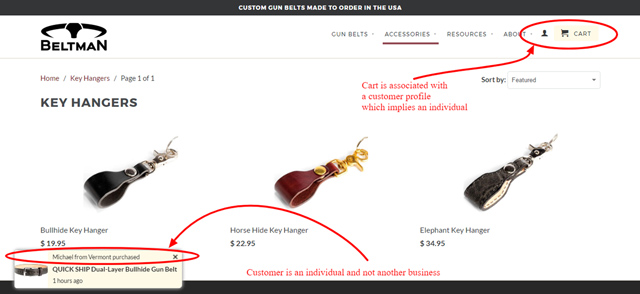
2: Business-to-Consumer (B2C)
When using this business model, websites sell their products directly to the end-consumer. This is typically called a retail model and it’s the most widely known one.
You wonder how it works?
For instance, you go to Beltman eCommerce store, buy key hangers and wear them as an end-consumer instead of reselling it to someone else. As simple as that!

3: Consumer-to-Consumer (C2C)
In this case, eCommerce websites help consumers connect with other consumers and sell to each other.
For example, Etsy can help you as an individual buy these Star Wars inspired prints directly from another individual.
The same kind of direct sale can also be made via eBay or Amazon Marketplace, or some less known platforms for artists, Society6 and Redbubble.
Of course, it’s possible for an eCommerce business to combine more than one of these models instead of using one of them exclusively.
Business Models Based on What’s a Store Selling
There are various types of products one can sell on the Internet. Some of them are physical and some of them are digital. Therefore, we can also classify eCommerce business models according to the nature of their product.
1: Selling Physical Products
Since it’s the most popular type of product to sell, the majority of online stores usually sell physical goods i.e. tangibles such as clothing items, jewellery, various equipment, and the like.
Here’s an example of a physical product: a beach shelter/tent from Gazebos Australia online store.
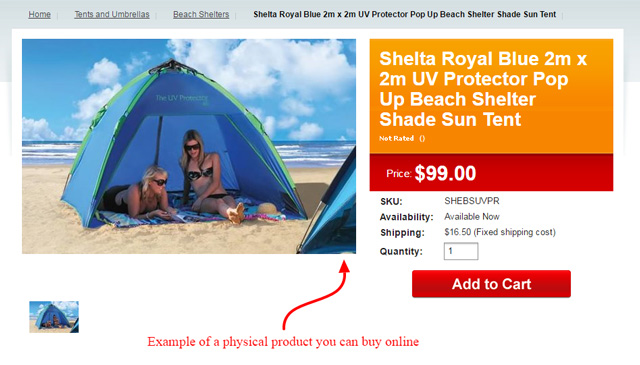
The biggest challenges one may encounter when selling physical goods could be inventory storage, shipping, and breakage.
2: Selling digital products
Another popular product type to sell online are digital goods. It can be anything from e-books, software, images, videos, music, and the like.
Here’s an example of a digital product: an e-book from Amazon Kindle e-books store.
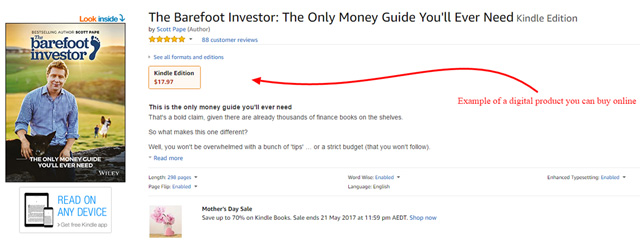
As opposed to selling physical goods, digital goods are digitally delivered usually immediately after purchase, so there are NO problems related to shipping or inventory management.
However, every digital product lends itself to piracy, which is difficult to control worldwide and it’s the biggest disadvantage of selling this type of product.
Business Models Based on Methods of Acquiring New Products and Inventory
With reference to how an online store acquires its products, there are also various methods and business models based on them. We’re going to mention the most common ones in this lecture.
How does this concern you? Being an eCommerce employee, your business role may depend greatly on the type of business model of the store you are working for.
For example, copywriters will write different copies directed to other businesses, while those that write for the retail eCommerce stores will write different type of content.
Online marketers will take a different approach to advertising manufacturing eCommerce stores than those who advertise white-labelling eCommerce stores.
Not to mention big differences that the customer service staff has in their job descriptions depending on the business model of their employer.
1: Retailing
Retailing is selling goods in small quantities to the end consumer for personal non-business use rather than for resale. It involves a direct interface with the customer.
In other words, a retailer purchases goods at lower prices and in bulk from the wholesaler and resells the same goods at higher prices and in small quantities to the end-consumers.
In even simpler words – it is what your usual corner shop does, just online.
There are different types of retailers and here we’re focusing on web retailing, also known as e-tailing or the Internet retailing, as its fastest growing segment.
Even though it’s advantageous in many ways (primarily for easy access to market and potential for rapid growth), here are some disadvantages of the Internet retailing:
- website and advertising costs (although it’s cheaper than opening a physical store);
- it might be more difficult to acquire customers and build trust;
- electronic transactions might not always be secure so customers are reluctant to supply their credit card details because they may be afraid of hackers;
- slow data transfer due to network limitations may be frustrating for customers;
- possible late delivery of goods customers ordered for special occasions (e.g. Christmas presents) may badly affect the retailer’s reputation
- a very specific e-tail problem is the shopping cart abandonment issue
Examples of the giant online retailers are Amazon and eBay. But, smaller businesses can also get involved into the retail.
Take Batteries for example. They re-sell goods that are produced by big brand names as Duracell or Panasonic:
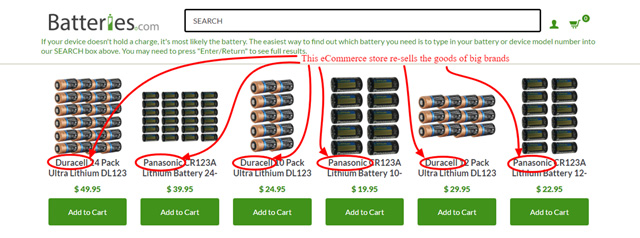
An online store which deals with retailing has to take care of:
- offering competitive prices,
- developing personal contact and providing maximum satisfaction to the consumer
- conducting marketing strategies to attract customers
- visual merchandising and display of goods,
- advertising and sales promotion campaigns,
- ensuring after-sales support, storage, physical damage of goods, price fluctuations, delivery/distribution of goods and many more.
This is definitely too much work for just one person. Therefore, it means that eCommerce retail stores have to hire a lot more people like yourself in order to stay operational. Customer service staff, online marketers, virtual assistants and copywriters all need to be involved in running this type of store.
2: Wholesaling
Wholesaling refers to buying goods in bulk at low prices from the manufacturer or producing them and selling them at a higher price typically to the retailer for resale or business purpose.
This business model requires higher upfront investments for purchasing and storing products. This is also a common method in B2B market.
The wholesaler sells already established and familiar brands on the market thus lowering the risk of wasting time and money in products no one wants to buy. On the other hand, it’s difficult for a wholesaler to stand out because the same products are available from multiple sources.
If one’s selling a wide variety of products, they probably have to deal with multiple supply partners, which may be as challenging as inventory management.
MX Wholesale is a good example of an online store doing wholesaling. They resell a selection of products and brands which they purchase from numerous manufacturers.
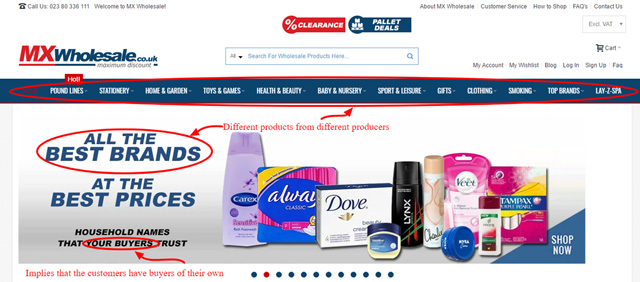
While an eCommerce store owner will be the one to make the deals, the entire operation besides that can be conducted by other eCommerce employees. These websites still need to be created, designed, advertised and run by others.
If you end up working for a wholesale eCommerce store, it is highly desirable that you know the basics of this business model.
3: Dropshipping
This is a business method where online stores sell goods they do NOT actually have in stock but they purchase a product from a third party (usually a wholesaler or manufacturer).
When a customer places an order, the supplier fulfills it and ships the product directly to the customer on behalf of the online store.
Dropshipping business model is generally low-risk and high-reward.
The benefits of dropshipping are:
- It does NOT require major up-front inventory investments.
- It gives online shops the possibility to diversify the inventory and test products.
- It’s easier to run an online store when one does NOT have to deal with physical products (packing and shipping orders, managing stock level, tracking inventory, managing and paying for a warehouse).
- The business can be run from ANY location in the world with an Internet connection.
Although this is the cheapest option to get one’s online business started, it certainly has its drawbacks, as well. Here are some of them:
- Online store owners have absolutely NO control over the shipping and fulfilling orders, so they may have to take responsibility for a mistake a supplier made.
- A mediocre supplier’s mistakes such as low-quality packing, missing items etc. may damage a store’s reputation.
- It’s challenging to keep track of which products are in or out of stock, so one might sell a product before even realising it’s sold out.
- Profit margins are slim.
- A lot of stores are doing dropshipping so the competition is high.
Hello Matcha is a successful dropshipping seller, connected to the company from Japan that ships the goods to the customers.

As you can see from the personal experience of the founders of Hello Matcha eCommerce store, there is a lot of work to be done to start such a store. Web design, online marketing and similar tasks can be easily left to the aspiring eCommerce employees.
4: Manufacturing
This business model implies that a product is created by hand or machinery and then sold to either another business, a customer or even another manufacturer.
The pros of this model are:
- having full control over one’s own brand, product quality, and its price;
- the possibility to adjust products on the fly if needed;
- margins are higher.
The cons are:
- NOT all products can be hand-made so stores like these can offer a limited choice of products;
- higher primary costs (purchasing raw material, labour, inventory storage);
- producing the goods on one’s own is time consuming;
- making one’s own products may become challenging as one scales up.
The example of this business model in practice is Earlywood Design. They sell wooden items and all of them are manufactured in their own company.
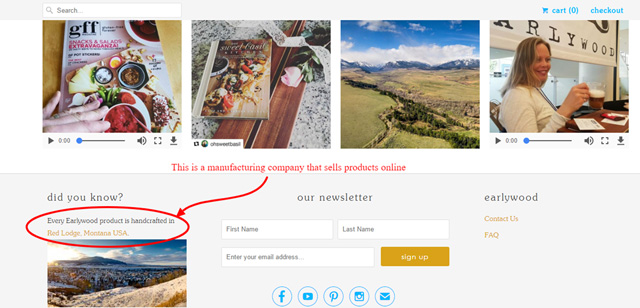
5: White Labelling
A white labelling eCommerce store doesn’t manufacture the product. It buys product from a manufacturer and put its own name and brand on the product before reselling it to the consumer. It involves mass production of products and their rebranding.
For instance, Dollar Shave Club does not manufacture their own razors. They use the products of other manufacturers, stick their brand to it and sell them as their own.
This model is good because it can save one’s time, money, and energy developing products which already exist. It’s also a way for both parties to succeed in business: the maker and the reseller of the product.
Good quality white label products also strengthen the loyalty of clients. Moreover, it allows an online store to benefit from other’s expert work legally.
Furthermore, slapping one’s brand name on a third-party’s high quality work definitely saves the store owner from going through the growing pains of launching their own product, testing, and perfecting it. What’s more, they can choose among numerous options.
However, they also have to invest in marketing, and to deal with selling the product and customer service.
For example, Gladditudes and LabRatGifts are two eCommerce companies that have gift products which usually involve clothing, mugs and the like. However, both of these companies are actually white labelling the products created by the Spreadshirt.
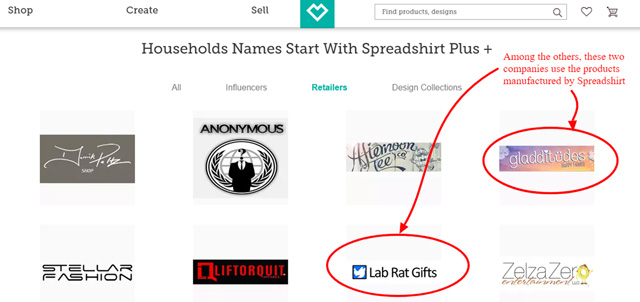
6: Affiliate Selling
This business model is simply about selling somebody else’s products in return for a commission. It’s similar to old-fashioned door-to-door selling, but this time – online.
So, the eCommerce stores with this business model have to find a product to promote and sell, find the top keywords for the niche, write some unique valuable content around those keywords and build a website around that product.
Take a look at this Amazon affiliate website: Sweethome Reviews. They provide valuable content which leads the visitors of their websites directly to the Amazon product pages, where they can make a purchase.
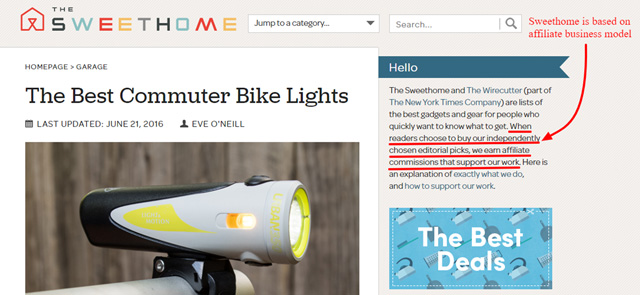
If you inspect the website, you will see that they do not have the shopping cart option or a checkout. They only have reviews of products and links to them which lead to the Amazon website.
Here is what happens when you click on some of them:

It is obvious that the eCommerce copywriters and eCommerce marketers have a lot to do when it comes to this type of eCommerce business model since these types of website require a well-written, interesting content that is properly advertised.
Basically, this can be incredibly lucrative in terms of the profit margins one can earn per sale with just one website and a bit of content.
Why? Well, because one can be given a cut of the profits NOT only for what they sell but for some actions towards buying other products visitors take via their website.
This model is one of the easiest to manage and starter-friendly. Of course, as any other model, it also has a bunch of benefits and flaws.
Some of its benefits are:
- There’s a wide variety of products one can promote and sell.
- There are NO actual products to ship or be responsible for, NO real store to look after, NO need to deal with logistics and customer service (one just directs customers’ enquiries to the merchant).
- It can be an excellent source of passive income.
- Haven’t we mentioned that one can get paid a commission even if they don’t sell anything?
- The risks are extremely low.
Although it may be a quick and easy way to run one’s business from home or anywhere in the world, this model also has some flaws.
- Affiliates CANNOT control the entire process, which offers less growth ability.
- They do NOT set the product prices (unlike dropshipping).
- It’s incredibly competitive due to the low barrier to entry, that is to say, there are a lot of people selling the same product so it’s challenging to stand out.
- This also means there’s a lot of scamming in this area so it’s difficult to earn the customers’ trust.
- Payments may be delayed and it’s also possible to lose all the money an affiliate invested into marketing whereas their merchant closed down/declared bankruptcymeanwhile.
All in all, the success here mostly depends on one’s content marketing skills and the type of products they choose to sell. In other words, eCommerce store owners will need help from high-quality marketers and copywriters. That is where you come in.
7: Crowdfunding
Crowdfunding is evolving and diversifying rapidly thanks to digital media. It can be a great way for innovators, artists and other prospective entrepreneurs to attract people’s attention, validate their ideas, and raise capital from other people without going into debt.
In simple words, it means that a person presents their project and then asks others for a small, affordable donation. In return, the donors are given a small reward.
The major platforms for carrying out successful crowdfunding campaigns are Kickstarter and Indiegogo. They provide another option for startups to raise money for their own projects or ventures and make it easier to fund a new business.
Take a look at the Kickstarter project for Troxes. It is a product that combines origami and Lego into interesting building blocks. On this page, the owners present the project, offers different donation options (pledges) with different compensation options.
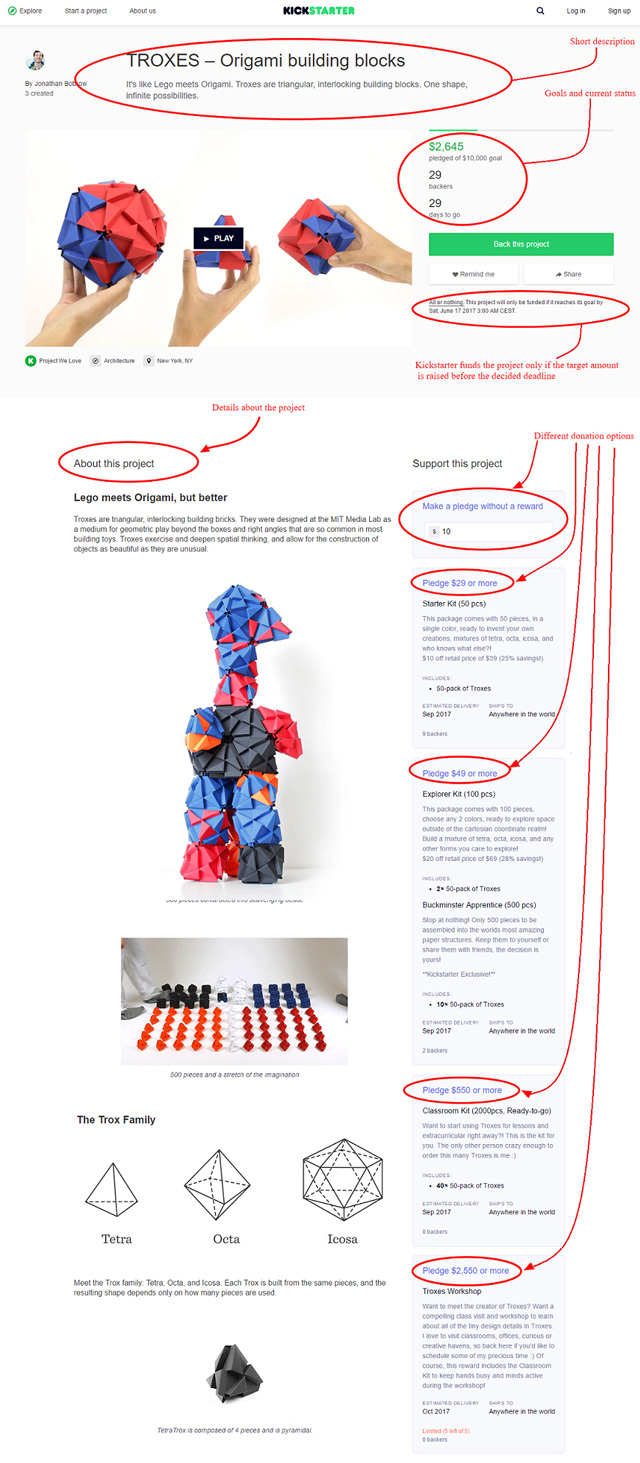
This model also allows eCommerce businesses to test consumers demands before they start manufacturing the product and possibly to build a fan base in advance.
These platforms provide a ready market place for that new business. It’s also suitable for launching new products within an existing business.
eCommerce businesses that choose this type of business model can easily overestimate or underestimate the funds they need and their campaign can fail.
Also, platforms like Kickstarter don’t pay out the projects that do not collect enough money before the set date, which means that it is possible to waste a lot of time without any effect.
However, this model has a huge potential and can play an important role in retail eCommerce growth so that’s why you should know a bit about it.
Business Models Based on the Store’s Selling Channels
According to the channels an online store uses to sell its products, the following business models can be defined.
1: Selling via One’s Own Store
Selling products via one’s own store is an online business area many virtual assistants and other online workers who go through these courses will most likely be working within.
Online stores that use this business plan sell their products directly to their customers. For example, business owners who manufacture T-shirts set up their own stores using tools like Shopify, Bigcommerce, or Woocommerce.
You can take a look at some of the best Shopify, Bigcommerce or Woocommerce stores. Here is the Woocommerce showcase, just to give you an idea.
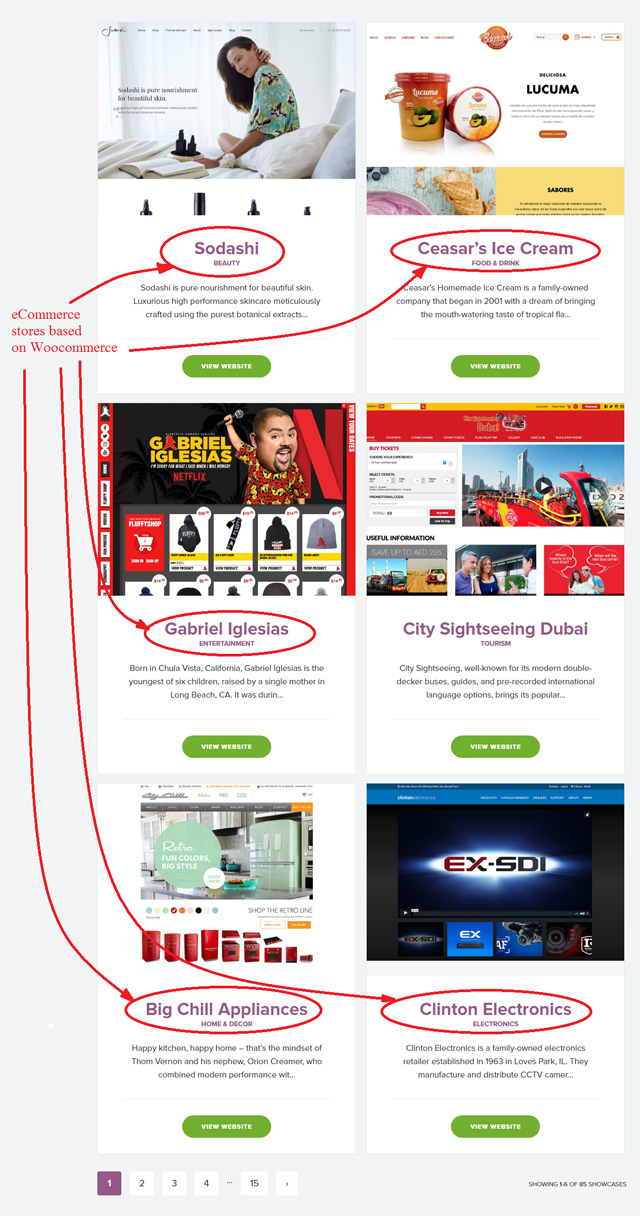
In other words, they own that store, which is like owning their own shop on a road in the middle of their town, where customers come.
The biggest benefit perhaps is that such store owners have the highest level of control since they decide upon the look of their store and all other details when setting up their own eCommerce site.
The next positive thing is that they get their own customers without having to share them with anyone else as opposed to the following two business models presented here (selling via intermediaries).
However, it costs A LOT of money to set up and run one’s own online shop. Moreover, it’s quite difficult to achieve scale i.e. to grow to some 50,000 customers and 500 blog articles for instance. Besides, they have to pay a lot for advertising to get those individual customers, as well.
All in all, this way of conducting business takes a lot of time, work and money and that’s exactly why some people choose one of the following two ways, that is to say, selling via other’s business channels.
So, let’s learn something more about that!
2: Selling via Someone Else’s Store
Instead of having one’s own store for selling products it’s also possible to chose a different option – to sell the products via an intermediary, that is to say, someone else’s store.
For instance, imagine you want to start selling jewellery online. You’d probably first ask yourself where to go and find a massive audience i.e. a customer base that already exists.
Why? Because it’s easier and cheaper than starting from a scratch!
So, you could choose a tool like Amazon, for example, and benefit from it. You wonder how? Well, what you get is a huge injection of customers instantly!
The other side of the coin is the enormous risk of getting the whole business shut down especially if store owners put all their eggs in one basket. How come?
There are a few possible scenarios:
If one stuffs up when working on the Amazon system, they get kicked off the platform.
Store owners are at risk of those platforms/channels just shutting down, which means the customers are lost as well.
As opposed to this, when one sells via their own channel (store), they don’t have to share the customers because those customers are theirs alone.
Some of the most famous platforms which are used as channels for selling in this business model are Amazon, Etsy, eBay, AliExpress etc. Here is an example of an Amazon store: Bottled Up Designs:
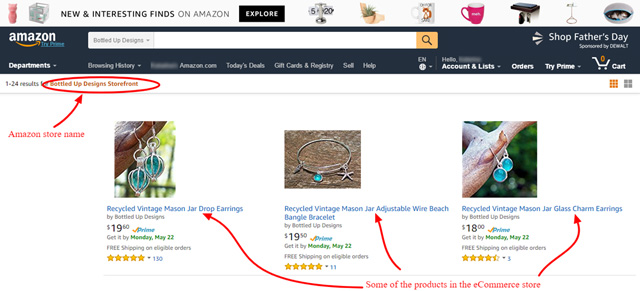
3: Selling via Social Channels
Selling products via social channels is on the upswing nowadays. Since the number of people who use social media is getting bigger and bigger every day, using this business model makes it very easy to communicate with one’s potential customers and to find out what product they are interested in.
This model is also known as social shopping, which is the blend of social media and eCommerce i.e. shopping aspect.
Explained in simple words, when an online store that sells T-shirts also has its Facebook page which allows it to actively put its products before the customers and easily spark conversations about the products.
Then, that store posts pictures of their T-shirts on their Facebook page with a “Shop Now” button, which allows customers to buy the product through that social media channel.
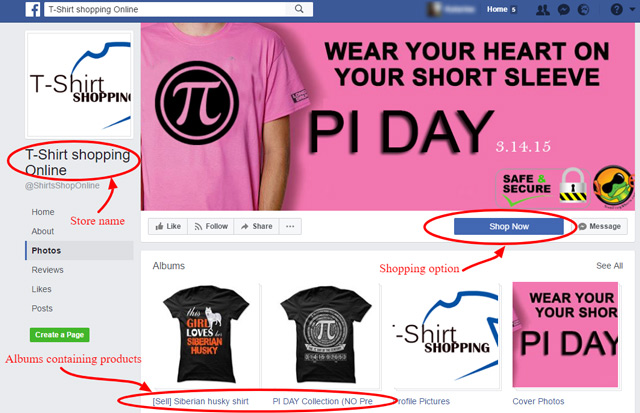
It’s actually a no-brainer, right? And it’s interesting!
This totally new type of selling also has both its advantages and disadvantages just as any other.
- On the one hand, a store gets access to broad swathes of instant customers, which is absolutely amazing, isn’t it?
- There’s also a more direct contact to prospects, which is precious.
- What’s more, it’s a cheaper marketing option and it’s easier to handle.
On the other hand, there are certain disadvantages such as:
- Your employer, a store owner, does NOT own those channels so it’s very hard to control them.
- These tools can and do change very rapidly, so it’s challenging to always keep up-to-date with them in order to stay alive and sell products to customers.
- If the platforms disappear one day, all one’s customers will disappear too.
All in all, no matter how difficult it might be to start especially for a store which is new to social media, the benefits of this business model far outweigh the challenges.
Among many other tools and networks are Facebook, Twitter, Instagram, Pinterest, LinkedIn. One of the most popular platforms of this type is also Wanelo.
It is a shopping source that provides pictures of products, prices and direct links to how to buy a certain product. Users really love it since it has a button for everything (for saving a product, for example).
Below, you will find an example of what a Wanelo store looks like. In this case, it is a Spool No.72.
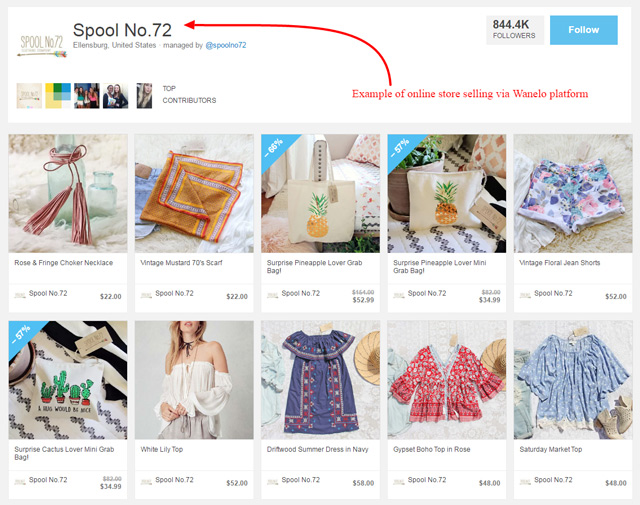
If you want to find out more about which social media platforms drive the most sales, feel free to follow the link provided.
In Summary
When it comes to selling products online, one of the most important things is to choose the appropriate business model that will best suit an online store’s needs, customers, and products.
The business models presented in this lecture are the prevalent ones these days. However, it’s important for you to realise that there are numerous ways of selling online and that business models as well as the channels change all the time.
That’s exactly what makes eCommerce a very exciting industry to work in! Don’t you agree?
The fact is that different eCommerce companies operate on different business models. They can even come up with a completely unique model of their own combining models based on the following criteria:
- Who is selling to whom (B2B, B2C, C2C)
- What they’re selling (physical or digital products)
- Where they got the products from (retailing, wholesaling, warehousing, dropshipping, making a product, manufacturing, white labelling, social shopping, affiliate selling, crowdfunding)
- How they’re completing the sales process (selling via one’s own store, someone else’s store, or social channels)
These are business models most commonly used in eCommerce, so you’ll come across them as you develop your online career in this industry.
Remember, all these different business models can overlap and intertwine. There’s NO right or wrong business model but a plenty of room for more models to coexist.
It’s also important to understand that businesses can succeed or fail whatever model they choose because it’s NOT a matter of WHAT they do but HOW they do it.
Frequently Asked Questions
1. Three most commonly used business models based on who’s selling to whom are:
a. B2R, B2C, B2C
b. C2T, C2C, B2B
c. B2B, B2C, C2C
2. What is the main characteristic of the B2B business model?
a. You are selling to the end user
b. You are selling to another business
c. Buyers are selling to other buyers
3. You have to use only one business model when selling products online.
a. Yes
b. No
4. Wanelo helps you sell:
a. Via social channels
b. Via someone else’s store
c. Via your own store
5. Which selling option is based on WordPress?
a. Wanelo
b. Woocommerce
c. Etsy
6. According to the methods of acquiring new products an online store chooses, some of the most common business models are:
a. dropshipping, manufacturing, wholesaling
b. selling physical and digital products
c. selling via one’s own store, selling via someone else’s store, selling via social channels
